- Integrated heat and power management of buildings with the energy recovery of a cement plant
Jin-Kuk Kima,*, Miae Kima, Michael Binnsb, Jae Ha Leec, Haejin Chod and Sung Chul Yia
aDepartment of Chemical Engineering, Hanyang University, 222 Wangsimni-ro, Seongdong-gu, Seoul 04763, Republic of Korea
bDepartment of Chemical and Biochemical Engineering, Dongguk University, 30 Pildong-ro 1-gil, Jung-gu, Seoul 04620, Republic of Korea
cG-ENONE, 268 Hagui-ro, Dongan-gu, Anyang-si, Gyeonggi-do 14056, Republic of Korea
dK-water Institute, 200 Sintanjin-ro, Daedoeck-gu, Daejeon 34350, Republic of KoreaThis article is an open access article distributed under the terms of the Creative Commons Attribution Non-Commercial License (http://creativecommons.org/licenses/by-nc/4.0) which permits unrestricted non-commercial use, distribution, and reproduction in any medium, provided the original work is properly cited.
The study aims to discuss the characteristics of heat-to-power ratios for CHP (Combined Heat and Power) systems and to understand the techno-economic impact on design and operation of CHP-based energy systems. The design procedure, subject to energy storage and energy demand profiles is suggested in a systematic and integrated manner to determine the minimum capacities of heat and power required and additionally to obtain any surplus or deficit of energy to be imported or exported. Investigation is also made to improve the cost-effectiveness for the energy management of building by integrating industrial waste heat and its use for the CHP unit. The case study is presented to illustrate how overall strategy for energy management of CHP systems are heavily dependent on power-to-heat ratio of the prime mover and to demonstrate economic benefit of heat integration between CHP-based building and an industrial site
Keywords: Combined Heat and Power, Microgrid, Waste Heat Recovery, Heat Storage, Electricity Storage
Achieving net-zero emissions by 2050 is described as the world’s most urgent mission [1], which demands urgent and global commitment to cutting harmful greenhouse gases. Among wide ranges of measures to build carbon-neutral society, the preferential utilization of sustainable technologies for distributed energy systems have been widely introduced and operated. Combined heat and power (CHP) is widely regarded as a practical mean for supplying energy in an energy-efficient and cost-effective manner to a microgrid or district energy systems in distributed energy environment [2]. CHP is a proven and reliable option towards the achievement of low-cost and sustainable reductions in CO2 emissions [3]. Recent study confirms the multiple benefits of CHP systems and increasing the share of CHP systems leads to a considerable reduction of energy consumption by 13-16% of total power and 19-27% of total heat production of Europe in 2050 [4].
Although CHP systems is able to utilize fuel more effectively through co-generation of electricity and heat, care should be taken in the design and operation of CHP systems due to the dynamic nature of energy demands. Consumer’s demand for heat and electricity changes with time, day and seasons, which requires systematic operational management of CHP systems. The flexibility gained from cogeneration in CHP systems may not be always favored because of practical limitations related to contractual obligations [5] or operational characteristics of prime movers. Energy storage is then introduced to balance energy demand and supply, with which peak demand can be reduced and fuel can be saved. Thermal energy storage is particularly important when energy is not continuously and steadily generated, for example using solar power [6]. The simultaneous use of thermal energy storage together with electricity storage systems is more economic and environmental-friendly which can have better flexibility and responsiveness in energy demand [7]. CHP systems are designed with different mechanisms for cogeneration, including gas turbines, gas engines, fuel cells, steam turbines, etc., and their operating characteristics and limitation are very technology-specific [8]. One of key aspects to be considered is the heat-to-power ratio of a CHP unit, which can be useful for providing a holistic guidance for simultaneous heat and power management based on CHP systems [9]. However, this work focused on large-scale urban energy systems covering a number of cities. Therefore, this work aims to systematically consider the characteristics of heat-to-power ratios of CHP systems for the application of buildings. The consideration energy storage is simul- taneously made for the sizing of CHP systems, with which the energy-efficient supply of energy and its storage is determined.
On the other hand, in order to fully appreciate sustainable benefits of distributed energy systems, it is necessary to minimize any waste heat from energy producers or consumers which is currently discharged without being recovered. There is considerable amount of waste heat available from industries [9] and its effective utilization within or beyond the industry can be promising [10]. A cement plant is selected in the case study, in which the utilization of waste heat is collectively designed with CHP systems and the economic benefits from integration of waste heat is evaluated. A wide range of technical options for improving energy efficiency in cement processing were listed with the application of energy modeling and scenario analysis [11], while multi-criteria decision-support tool was developed to screen systematically different energy-saving options [12]. The application of heat integration method to the cement industry was carried out to assess theoretical potential for energy saving and to provide design guidelines for heat recovery systems [13]. The integration of industrial waste heat recovery from a cement plant for district heating network was previously studied [14]. However, this study was limited to consider only heat demand for consumers, without considering electricity together. Hence, in this study, cogeneration of heat and power is fully accommodated for the targeting of CHP systems, subject to heat-to-power ratio and demand profiles, with which the minimum energy storage capacity is readily sized.
A CHP unit is typically used for the supply of heat and electricity to commercial or residential buildings. A gas turbine or a reciprocating engine is often introduced as a prime mover for the CHP system. A steam turbine linked with a steam generator can be considered when the large amount of steam supply is required. Recently, energy supply from fuel cells is another alternative as fuel cell can be operated quietly and has good part-load performance [15].
Operating characteristics of CHP systems are strongly dependent on technology-specific mechanisms to produce heat and power. Such difference results in different ranges for heat-to-power ratios (RH-P), as illustrated in Table 1. The CHP systems based on a reciprocating engine is better suited to the case of high RH-P. When further heat supply is desired, CHP systems based on a gas turbine can be considered. For the excessive supply of heat required, CHP systems based on steam turbines are to be selected. The ranges illustrated in Table 1 clearly imply that it is necessary to consider the heat-to-power ratio for the sizing of CHP units and to accommodate its impact on the operation of CHP units.
An example is considered here in order to gain conceptual understanding with regard to the impact of cogeneration and energy storage on distributed and microgrid energy management. Hourly profiles of heat and electricity demands for the building are given in Fig. 1. This information is taken from January data of a nursing home located in California, US, available in the reference [19]. For this example, the maximum recovery of heat and electricity through the storage is assumed with no energy loss during storage and transfer. This means that any surplus heat is accumulated in the heat storage and reused for the next time interval without being lost. The minimum capacity of heat generation required is then determined by finding the capacity such that overall summation of surplus and deficit heat is set to be zero. The same procedure is applied to find the capacity of electricity generation. The profiles of heat and electricity storage, as shown in Fig. 1(b) and 1(d), are inherently linked with the amount of heat and electricity capacities targeted, as the minimum generation of heat and electricity is based on the full utilization of storage throughout the time horizon. Additional capacity is to be added when heat and electricity loss is occurred.
The capacity of heat generation given in Fig. 1 is in- dependently determined without considering the capacity of electricity generation, and vice versa. As shown in Fig. 2, the heat-to-power ratio for this example is 1.11. However, the CHP unit to be implemented is likely to have different RH-P other than 1.11. Difference of RH-P between a desired value and an actual one results in surplus or deficit in the energy storage, which should be systematically considered for the energy management of buildings.
In this study, the sizing of a CHP unit, together with the operational management of surplus energy through the storage follows the design procedure given in Fig. 3. The capacity of heat generation, rather than electricity generation, is selected as the basis for the necessary capacity of a CHP unit, because the fulfillment of any deficit in electricity demand is relatively simpler and more straightforward than fulfilling deficits in the heat demand. Based on the heat demand data, the size of CHP systems is determined, together with the size of heat storage. Based on the given or selected RH-P from the CHP unit, the capacity of electricity generation can be determined, which is then applied for the electricity demand profile given. Calculating capacities of energy generation and storage, operating profiles for accumulation or usage of energy through storage can be obtained and strategies for energy export or import can be set up. It should be noted that the procedure show in Fig. 3 can be adjusted by putting the capacity of electricity generation as a basis for the design procedure.
The procedure explained in Fig. 3 is now illustrated with the example discussed in this section. The heat demand profile given Fig. 1(a) is used for targeting the heat generation capacity for the CHP unit. As explained earlier, the minimum capacity to satisfy the heat demand without any external heating source is 653.8 kW, in which the maximum capacity required for heat storage is 932.5 kW. The illustrative value of RH-P is taken as 1.25, which is used to determine the capacity of electricity generation to be 523.0 kW. As the capacity specified (i.e. 523.0 kW) is less than the capacity targeted (i.e. 589.8 kW), the electricity generation from the CHP unit is not enough and the power import is necessary. The step-by-step calculations are schematically explained in Fig. 4.
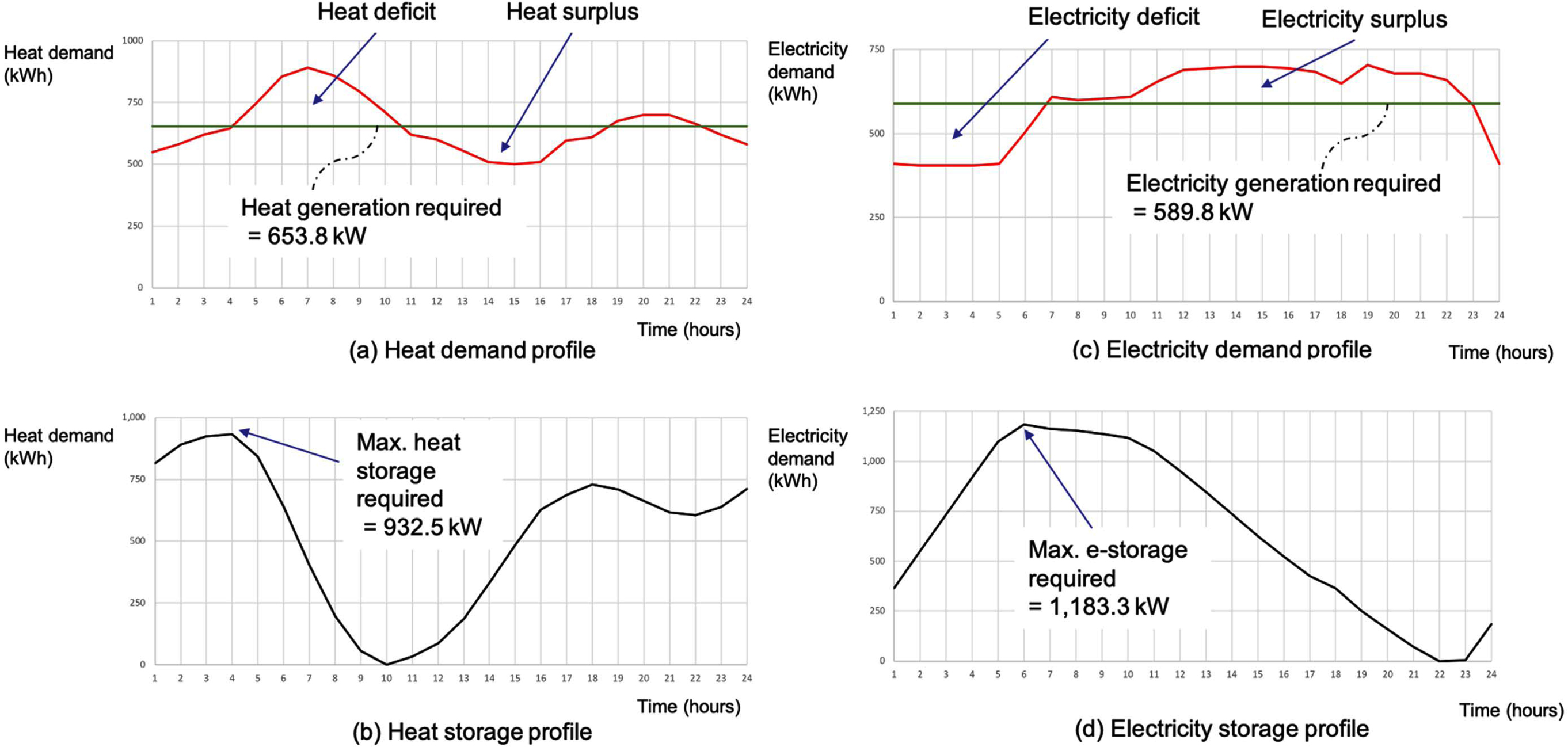
|
Fig. 1 Heat and electricity daily demand for a building. |
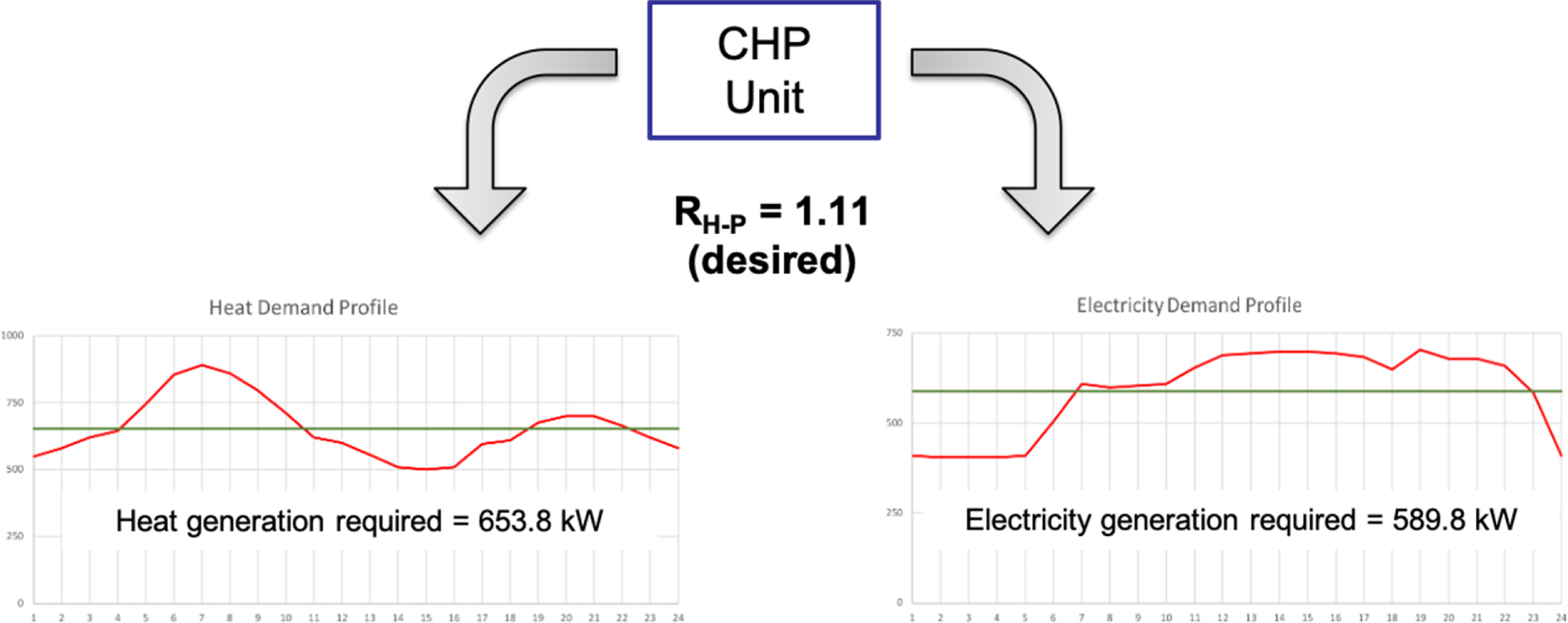
|
Fig. 2 Heat-to-Power Ratio for a CHP unit |

|
Fig. 3 Procedure for the design and energy management of CHP systems. |
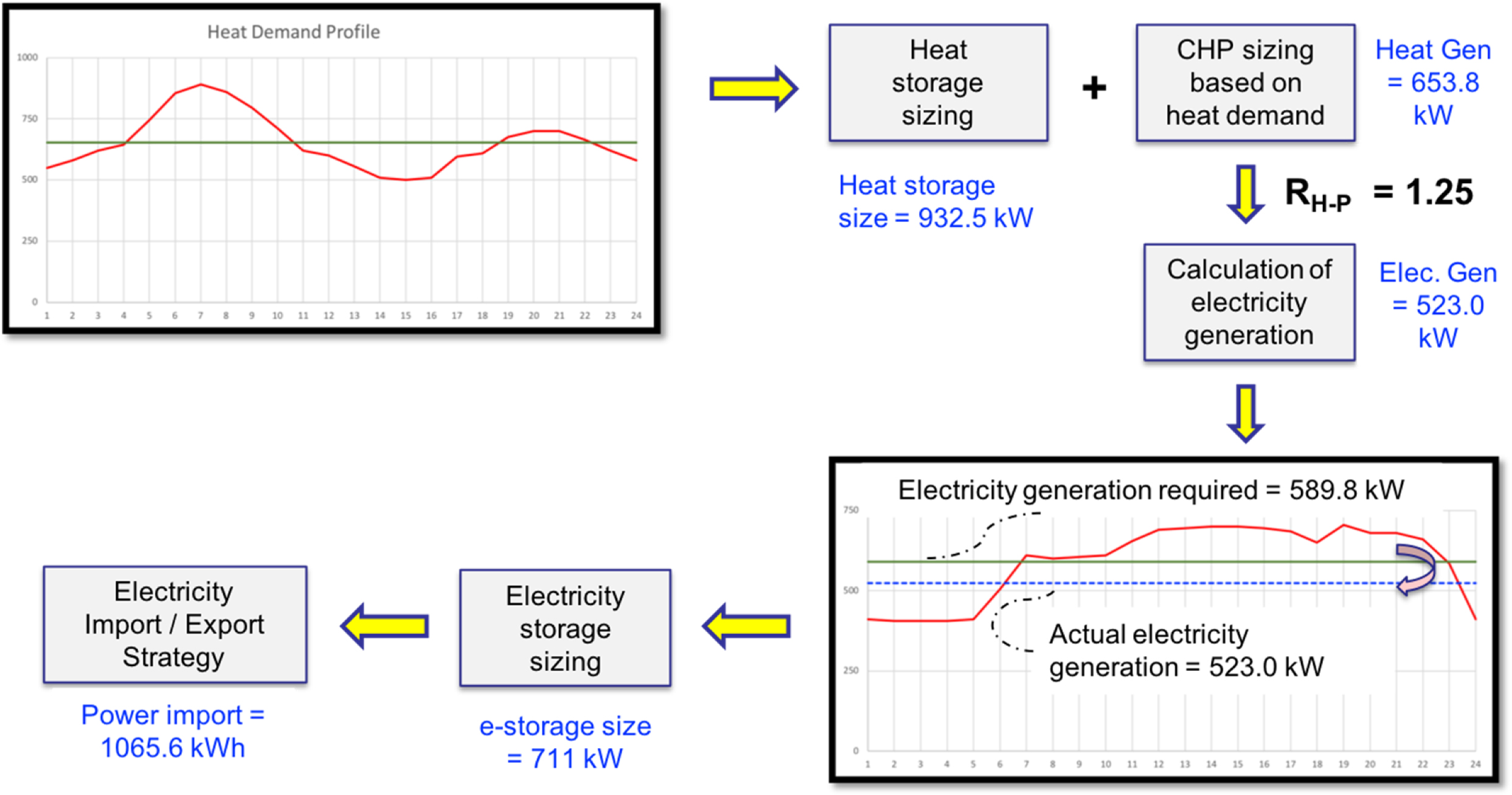
|
Fig. 4 An illustrative example for the consideration of the Heat-to-Power Ratio for the CHP systems. |
Option 1 in this Case Study refers the case in which the stand-alone CHP system is used for the supply of heat and electricity. The integration of industrial energy sources with the CHP system is referred to as Option 2, which utilizes waste heat available from a cement plant.
Daily profiles of heat and electricity demands used for the example in the previous section is further used for the case study. In addition to the profiles of January, the case study considers both July and January from the literature [19] as given in Figs. 5 and 6, with which different heat-to-power ratios are considered. Contrary to the example study in the previous section, the case study considers the loss of heat and electricity during storage and its re-utilization. The assumption is made that 5% of heat and electricity per every hour is lost in the storage facility, although the loss rate is very case-specific and technology-dependent on energy storage [20].
Daily demand profiles of heat and electricity for winter are shown in Fig. 5 and those for summer in Fig. 6. Heat consumption for winter is larger than for summer, while electricity required for cooling during summer is the main contributor to large electricity demand, compared to winter. Considering energy loss, the minimum capacities for heat and electricity generation for winter are increased from 653.8 kW and 589.8 kW to 681.7 kW and 620.9 kW, respectively. The ratios of increase for heat and electricity is 4.2% and 5.2%, respectively. This difference in capacity increase is related to the shape of demand profiles. When two profiles between Fig. 5(a) and (b) are compared, the shape of heat demand profile is more effective than the electricity profile because of the longer residence time of electricity stored and accumulated over a longer time horizon.
Option 1 – A Stand-alone CHP System
The capacities of heat and electricity generation for winter and summer shown in Fig. 5 and 6 are indepen- dently targeted, without the consideration of specific RH-P. The technology-specific RH-P is taken to be 1.25 for the case study, with which the capacity for electricity generation is determined as shown in Fig. 7. The heat demand between summer and winter is different and the capacity of heat generation for the CHP unit is sized with the heat demand profile of winter. This decision is made as the heat demand in winter is large than that of summer and it is more practical to avoid under-sizing for heat generation capacity.
Considering the targeted capacity for the CHP unit, heat in summer is over generated, while the electricity is under generated, compared to the case without con- sidering RH-P. The amount of import or export of heat and electricity as well as overall energy cost are presented in detail in Table 2, which is reported in a daily basis for winter and summer, respectively. As, for summer, surplus heat may not be exported due to seasonal characteristics, energy cost is calculated depending on the possibility of heat export. However, no restriction on power export or import is assumed.
For the case study, LNG (liquefied natural gas) is taken as fuel for the CHP system and parameters related to the evaluation of energy cost are as natural gas price is 0.075 US$/ft3, [21], electricity purchase price is 0.1063 S$/kWh [21], district heating cost is 0.078 $/kWh [22] and overall energy efficiency of the CHP unit is 80%.
Option 2 – Energy Recovery with a Cement Plant
The industrial case studied is a cement plant produc- ing 1 million tons of cement per year, which is based on the study conducted by the International Energy Agency (IEA) [23]. Fig. 8 is a schematic process flow diagram for the cement plant considered and three possible streams to be further used for heat and recovery are shown with stream compositions and operating conditions. These three streams are referred as Steams 2A, 2B and 2C, which are exhaust streams to be emitted from the cement plant. As these three streams have different amount of waste heat to be utilized, the potential for energy recovery in conjunction with the CHP unit is further investigated.
Fig. 9 shows available options for heat integration with three streams identified from the cement plant. Stream 2A can be used for power generation as well as heat recovery, as this exhaust gas is emitted at relatively high temperature. ORC (Organic Rankine Cycle) is selected for generating power as the waste heat of Stream 2A can be used for evaporating the working fluid of the cycle. R245fa is selected as a working fluid for the ORC. All the calculations are carried out with AspenHYSYS® simulator and Peng-Robinson method is selected as thermodynamic and property evaluation package. Key assumptions and modeling basis follow the simulation framework reported in the literature [14]. Also, 5% of heat available from these streams is assumed to be lost during transfer and/or generation.
The ORC operating at winter is designed to generate 620.86 kW of electricity with which 4,240 kW of waste heat is utilized from Stream 2A. The remaining heat after being used for the ORC is used for the supplement of heating for the building. It is assumed that the water is used as a circulating medium to recover the heat from the cement plant, and the heating of water is from 55 oC to 95 oC. Assumption is also made that the maximum heat recovery for those exhaust streams is made down to 75 oC. For the operating mode of summer, 4,409 kW is utilized from Stream 2A for generating the power in the ORC cycle, and the re- maining 2610 kW is recovered for heating.
For Streams 2B and 2C, the application of ORC is not feasible, due to relatively low temperature for the evaporator of the ORC, and there is only waste heat recovery which is used for heating water as a heating source to the building. Waste heat available from Stream 2C is enough to provide heat necessary for the building, while the waste heat recovery of Stream 2B is not.
Tables 3, 4 and 5 shows the details of economic analysis for Options 2A, 2B and 2C, respectively. Option 2A can be seen as the most promising option, as the heat and electricity to be used for the building are covered from the industrial waste heat. Option 2B is the worst scenario due to the limitation in heat recovery without any potential for power recovery. It should be noted that economic analysis is only made for evaluation of energy cost, without considering capital investment required. If capital investment for the introduction of the ORC system or the facilitation of over-the-pence integration were considerably large, the economic benefit of energy recovery from the cement plant may not be seen as promising.

|
Fig. 5 Case study energy demand profiles of winter |

|
Fig. 6 Case study energy demand profiles of summe |

|
Fig. 7 A case study: Conventional CHP (Option 1). |
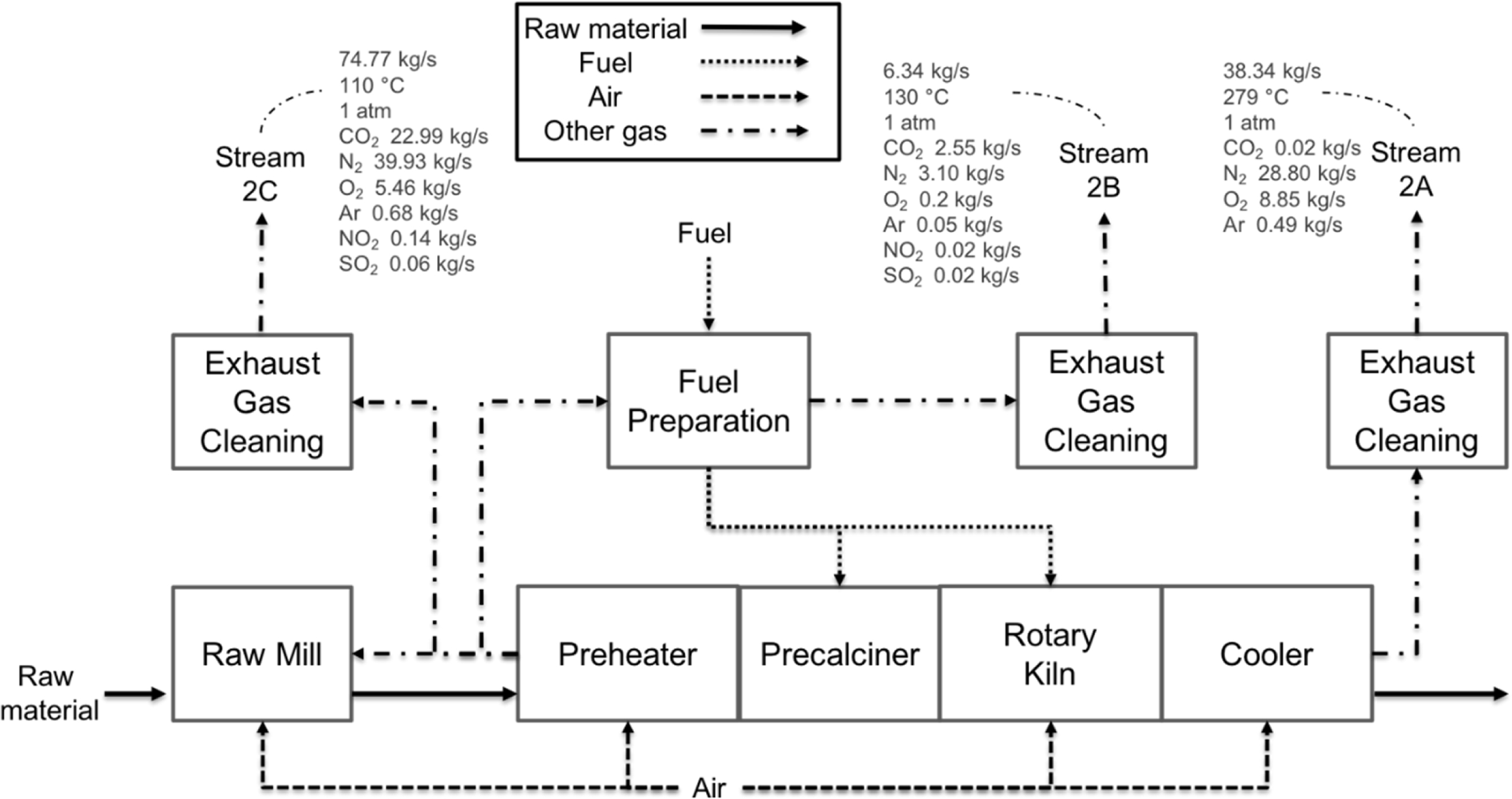
|
Fig. 8 Heat integration potential from a cement plant [20]. |
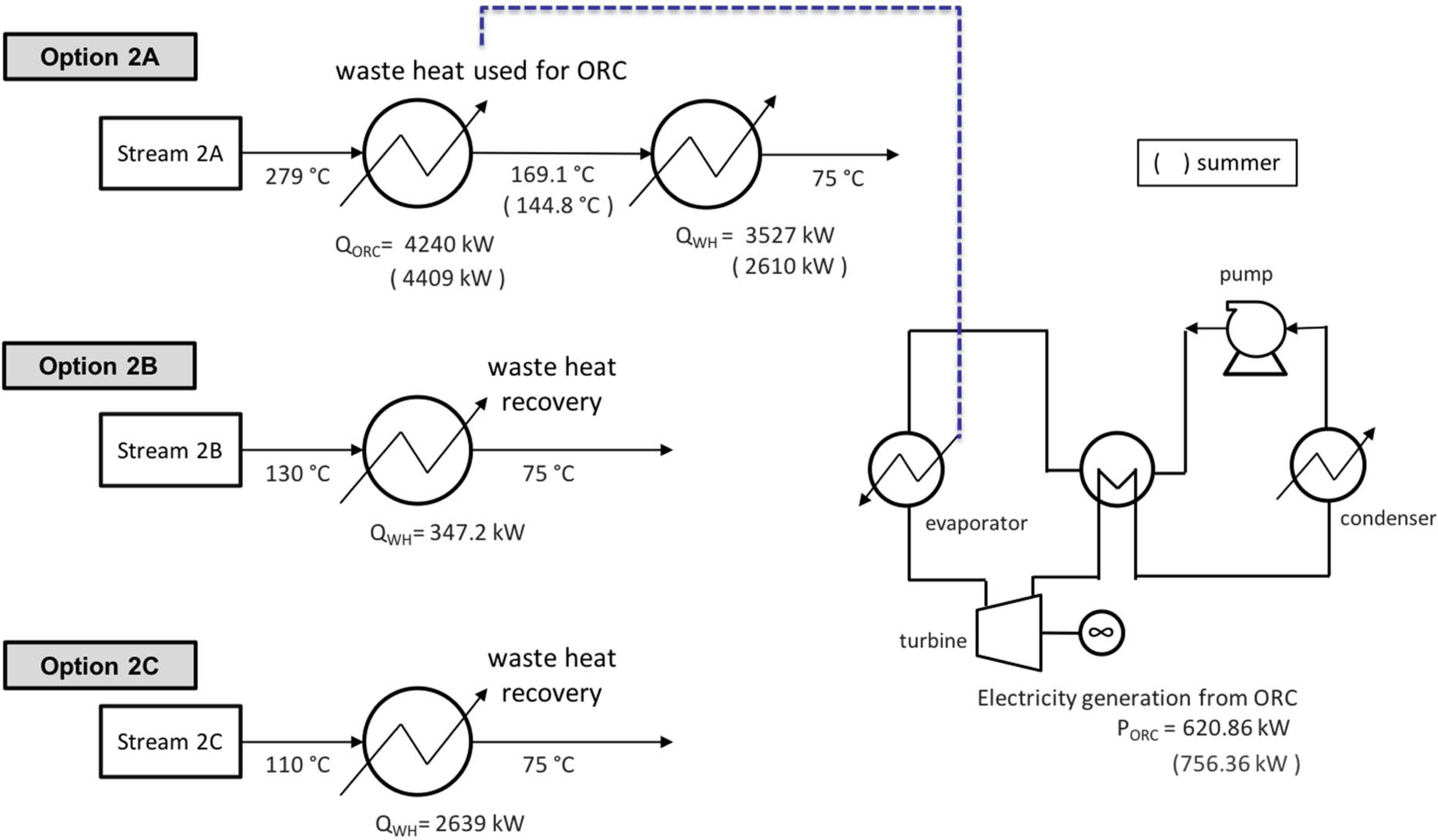
|
Fig. 9 Potentials for heat and power recovery. |
The study investigates how the relative difference between heat and electricity generation for CHP systems should be systematically considered for the design and operation of CHP-based energy management. The case study demonstrates the applicability of process design approach proposed with which the implementation of the specific heat-to-power ratio for the design and operation of CHP-based energy management can be made in a holistic and systematic manner. Also, the benefit of utilizing industrial waste heat from a cement plant is studied, with which heat or power recovery via the ORC cycle is maximized.
Considering the economic trade-off between energy and capital would be necessary as part of future work, with which understanding on the true value of industrial waste heat can be clearly gained. For the analysis of heat-to-power ratios for CHP systems, the realistic values of RH-P can be used for the analysis by developing mathematical models or by referring to performance databases, which is another area to be studied beyond the current work.
This work is a research conducted with the support of the Korea Institute of Energy Technology Evaluation and Planning with the government (Ministry of Trade, Industry and Energy) in 2019 (20192010106970, De- velopment of the integrated and decentralized smart hub thermal storage system for heat trading)
- 1. A. Guterres, in “Carbon neutrality by 2050: the world’s most urgent mission”, (last accessed on 2 Sep. 2021).
- 2. M. A. Bagheria, K Mehranzamir, Energy conversion and Management. 224(2020) 113454.
-

- 3. IEA, in “Combined heat and power: evaluating the benefits of greater global investment” (IEA, 2008) p.7.
- 4. Artelys, in “Towards and efficient, integrated and cost-effective net-zero energy system in 2050: The role of cogeneration” (last accessed on 2 Sep. 2021) p.23.
- 5. European Union, in “Case study on the impact of cogeneration and thermal storage on the flexibility of the power system” (European Union, 2017) p.2.
- 6. IEA-ESTAP and IRENA, “Thermal Energy storage: Technology Brief E17” (IEA-ESTAP and IRENA, 2013) p.1.
- 7. A Bandiasadi, D Habibi, W Al-Saedi, M.A.S. Masoum, C. K. Das, N. Mousavi, J. of Energy Storage 28 (2020) 101186.
-

- 8. US EIA, in “Distributed generation and combined heat & power system characteristic and costs in the building sector” (US EIA, 2017) p.2.23-2.38.
- 9. J.L. Pellegrino, N. Margolis, M. Justiniano, M. Miller, A. Thedki. “Energy use, loss and opportunities analysis – U.S. manufacturing and mining” (US Department of Energy, 2004) p.17-24.
- 10. S. Perry, J. Klemes, I. Bulatov, Energy. 33 (2008) 1489–1497.
-

- 11. A. Talaei, D. Pier, A. V. Iyer, M. Ahiduzzaman, and A. Kumar, Energy 170 (2019) 1051-1066.
-

- 12. A. Mokhtar, N. Nasooti, Energy Strategy Rev. 28 (2020) 100458.
-

- 13. K.A. Le, Chem. Eng. Trans. 63 (2018) 313-318.
-

- 14. H. Cho, S. Yoon, J.H. Lee, J. Cho, J. Kim, and S.C. Yi, J. Ceram. Process. Res. 22[1] (2021) 106-113.
-

- 15. US DOE, in “Combined Heat and Power Technology Fact Sheet Series: Fuel Cells” (DOE, 2017) p.1.
- 16. US DOE, in “Combined Heat and Power Technology Fact Sheet Series: Overview of CHP Technologies” (DOE, 2017) p.3.
- 17. UK BEIS, in “Combined Heat and Power – Technologies: A Detailed Guide for CHP Developers – Part 2” (BEIS, 2021) p.53
- 18. M.O. Apunda, B.O. Nyangoye, Open Sci. J. 2[3] (2017) 1- 16.
-

- 19. M. Sandler, C. Marnay, A. Siddiqui, J. Lai, B. Coffey, and H. Aki, in “Effect of Heat and Electricity Storage and Reliability on Microgrid Viability: A Study of Commercial Buildings in California and New York States” (Ernest Orlando Lawrence Berkeley National Laboratory, 2009) p.6.
- 20. M. Sasso, G. Angrisani, C. Roselli, in “Methodologies for the Performance Assessment of Micro Hybrid Polygeneration Systems” (Technische Universität München, 2014) p.10-26.
-

- 21. US Energy Information Administration, in “Energy Prices” (US Energy Information Administration, 2021) p.165, 169.
- 22. O. Gundmundsoon, J. E. Thorsen, and L. Zhang, WIT Trans. Ecol. Environ. 176 (2013) 3-13.
-

- 23. IEA, in “CO2 Capture in the Cement Industry” (IEA, 2008) p.4.1-4.3.
 This Article
This Article
-
2021; 22(6): 722-730
Published on Dec 31, 2021
- 10.36410/jcpr.2021.22.6.722
- Received on Sep 4, 2021
- Revised on Oct 14, 2021
- Accepted on Oct 16, 2021
 Services
Services
- Abstract
introduction
understanding on heat-to-power ratios of chp systems
case study: heat integration of the building chp system with industrial energy sources
conclusions and future work
- Acknowledgements
- References
- Full Text PDF
Shared
 Correspondence to
Correspondence to
- Jin-Kuk Kim
-
Department of Chemical Engineering, Hanyang University, 222 Wangsimni-ro, Seongdong-gu, Seoul 04763, Republic of Korea
Tel : +80 2 2220 2331 - E-mail: jinkukkim@hanyang.ac.kr







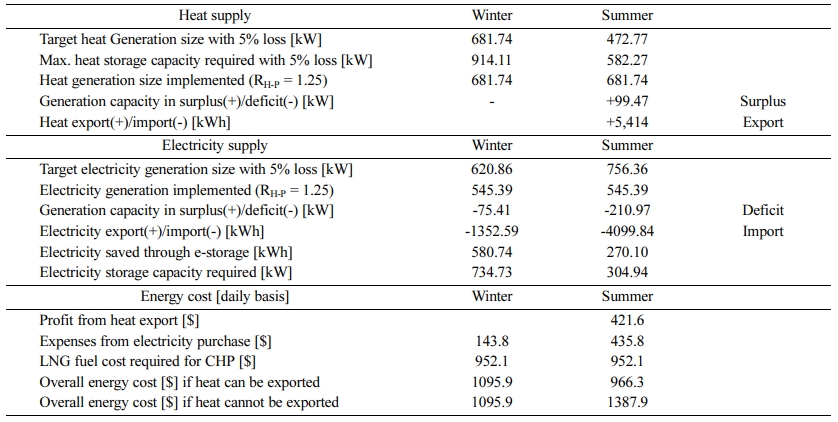



 Copyright 2019 International Orgranization for Ceramic Processing. All rights reserved.
Copyright 2019 International Orgranization for Ceramic Processing. All rights reserved.